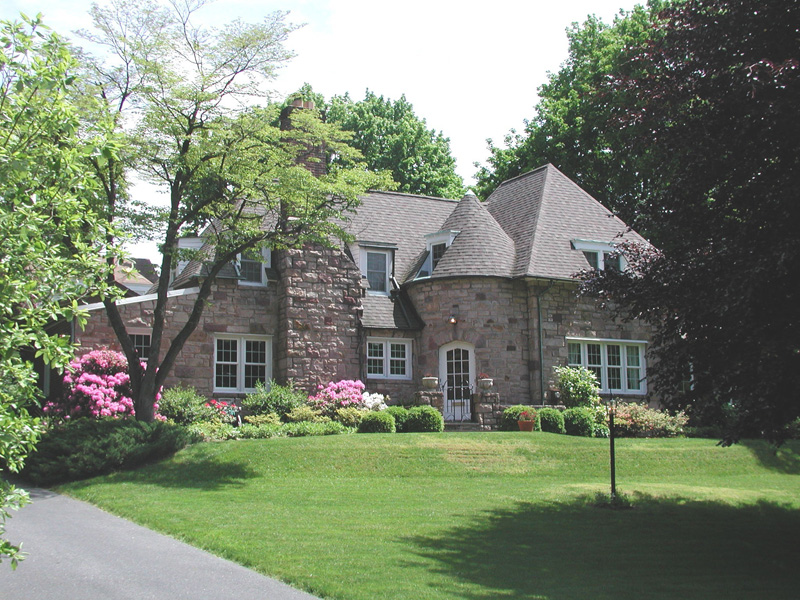Chateauesque style
The Chateauesque style (1860 - 1910) was an effort to recreate the appearance and stylistic elements of the palatial French chateaus of the 16th century. Buildings of this style are almost always architect-designed, grand places intended to impress.
Details borrowed elements from the Gothic style and the Renaissance style, just as the original chateau designs did. The Chateauesque style was popularised in the US by by architect Richard Morris Hunt, the first American to study at the Ecole des Beaux-Arts in France.
Chateauesque style buildings are easy to identify due to their imposing appearance and characteristic complex roof line with abundant detailing. Buildings of this style have steeply pitched hipped (and sometimes gabled) roofs, topped by cresting or finials, and pierced by decorative gabled wall dormers.
Low relief carving may ornaments the dormer gables and window surrounds. Chimneys are tall and have decorative corbelled tops. Another stand-out feature is a round tower topped by a conical roof, although some more modest examples of the style (as per the top image) may omit the tower.
Balconies may feature Gothic-inspired quatrefoil or arched tracery patterns. Entry doors often have round arches or a flattened arch with an ogee arch moulding.
Most examples of this rather rare style are found in a sophisticated urban setting or on an estate where such opulent, high-style buildings might be expected.
After the turn of the 20th century, elements of the Chateauesque style were incorporated into a revival form sometimes called the French Eclectic style. Identified by a round tower with a high conical roof and steeply pitched hipped roof, this style often appears in early-20th century neighbourhoods along with other popular revival styles of the the era, such as the Tudor and Colonial Revival styles.
Identifiable features:
- French chateau-like appearance.
- Round tower with conical roof.
- Steeply pitched hipped or gable roof, often with cresting.
- Tall chimneys with decorative caps.
- Round arch or flattened basket-handle arch entry.
- Multiple dormers.
- Quatrefoil or arched tracery decorative elements.
- Balustraded terrace.
- Usually of masonry (stone or brick) construction.
--Pennsylvania Historical and Museum Commission
[edit] Find out more
[edit] Related articles on Designing Buildings Wiki
Featured articles and news
RTPI leader to become new CIOB Chief Executive Officer
Dr Victoria Hills MRTPI, FICE to take over after Caroline Gumble’s departure.
Social and affordable housing, a long term plan for delivery
The “Delivering a Decade of Renewal for Social and Affordable Housing” strategy sets out future path.
A change to adoptive architecture
Effects of global weather warming on architectural detailing, material choice and human interaction.
The proposed publicly owned and backed subsidiary of Homes England, to facilitate new homes.
How big is the problem and what can we do to mitigate the effects?
Overheating guidance and tools for building designers
A number of cool guides to help with the heat.
The UK's Modern Industrial Strategy: A 10 year plan
Previous consultation criticism, current key elements and general support with some persisting reservations.
Building Safety Regulator reforms
New roles, new staff and a new fast track service pave the way for a single construction regulator.
Architectural Technologist CPDs and Communications
CIAT CPD… and how you can do it!
Cooling centres and cool spaces
Managing extreme heat in cities by directing the public to places for heat stress relief and water sources.
Winter gardens: A brief history and warm variations
Extending the season with glass in different forms and terms.
Restoring Great Yarmouth's Winter Gardens
Transforming one of the least sustainable constructions imaginable.
Construction Skills Mission Board launch sector drive
Newly formed government and industry collaboration set strategy for recruiting an additional 100,000 construction workers a year.
New Architects Code comes into effect in September 2025
ARB Architects Code of Conduct and Practice available with ongoing consultation regarding guidance.
Welsh Skills Body (Medr) launches ambitious plan
The new skills body brings together funding and regulation of tertiary education and research for the devolved nation.
Paul Gandy FCIOB announced as next CIOB President
Former Tilbury Douglas CEO takes helm.
UK Infrastructure: A 10 Year Strategy. In brief with reactions
With the National Infrastructure and Service Transformation Authority (NISTA).
























